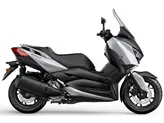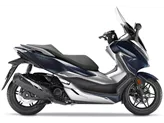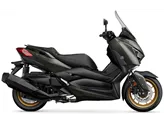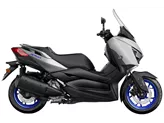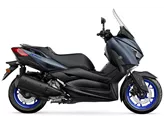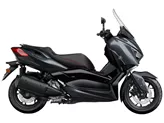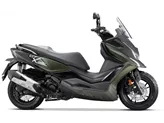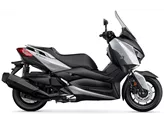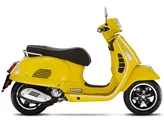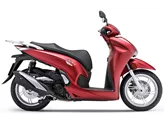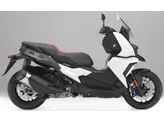Yamaha XMAX 400 2016 vs. Yamaha XMAX 300 2017

Yamaha XMAX 400 2016

Yamaha XMAX 300 2017
Overview - Yamaha XMAX 400 2016 vs Yamaha XMAX 300 2017
The Yamaha XMAX 400 2016 and the Yamaha XMAX 300 2017 are both popular scooter models offered by Yamaha. While they share some similarities in terms of engine power, transmission type, and suspension, there are also notable differences between the two models.
In terms of engine power, the Yamaha XMAX 400 2016 boasts a higher output with 31.5 HP compared to the Yamaha XMAX 300 2017's 28 HP. This means that the XMAX 400 may offer slightly better acceleration and top speed. However, the torque of the XMAX 400 is also higher at 34 Nm compared to the XMAX 300's 29 Nm, which could result in better low-end power and responsiveness for the XMAX 400.
Both scooters feature a centrifugal force clutch type and automatic transmission, providing ease of use and convenience for riders. They also have a single cylinder, 4-stroke engine with liquid cooling for optimal performance and reliability. The XMAX 400 has a larger displacement of 395 ccm compared to the XMAX 300's 292 ccm, which could contribute to its higher power output.
In terms of suspension, both models feature a telescopic fork front suspension and a unit swing rear suspension, providing a comfortable and stable ride. This ensures that riders can navigate various road conditions with ease.

Yamaha XMAX 400 2016
When it comes to braking, the XMAX 400 is equipped with double disk front brakes, while the XMAX 300 has a single disk front brake. This could potentially give the XMAX 400 better stopping power and control. However, both models feature a disc rear brake, ensuring reliable and efficient braking performance.
Both scooters are equipped with ABS (Advanced Rider Assistance Systems), providing an added layer of safety by preventing wheel lock-up during braking. This feature enhances overall stability and control, especially in emergency situations.
In terms of dimensions and weights, the XMAX 400 has a slightly longer wheelbase at 1565 mm compared to the XMAX 300's 1540 mm. This could contribute to better stability and handling for the XMAX 400. The seat height of the XMAX 400 is also slightly lower at 785 mm compared to the XMAX 300's 795 mm, which could make it more accessible for riders with shorter inseams.

Yamaha XMAX 300 2017
The XMAX 400 is slightly heavier with a dry weight (with ABS) of 211 kg compared to the XMAX 300's 179 kg. This could potentially affect maneuverability, especially at lower speeds. However, the XMAX 400 compensates for its weight with a larger fuel tank capacity of 14 liters compared to the XMAX 300's 13 liters, allowing for longer rides without the need for frequent refueling.
In terms of strengths, the XMAX 400 offers a powerful engine, comfortable seating position, ample storage space, and an attractive design. The XMAX 300, on the other hand, boasts a powerful Blue Core engine, smooth response, great chassis, Smart-Key system, traction control, generous storage space, LED lighting technology, and a high-quality finish.
As for weaknesses, the XMAX 400 is noted for its taut chassis and a fuel filler cap that could be more aesthetically pleasing. The XMAX 300, on the other hand, has been criticized for its soft brake, which may affect braking performance and confidence.
In conclusion, while the Yamaha XMAX 400 2016 and the Yamaha XMAX 300 2017 share some similarities in terms of engine and drive train, they also have notable differences in power, braking, dimensions, and weights. Ultimately, the choice between the two models will depend on the rider's preferences and priorities, whether it be power, handling, storage space, or overall design.
Technical Specifications Yamaha XMAX 400 2016 compared to Yamaha XMAX 300 2017
Pros and Cons in comparison
Pros and Cons in comparison
Yamaha XMAX 400 2016

The Yamaha XMAX 400 was the big surprise of the comparison test. The 395cc engine is brisk, so the 100 km/h limit is quickly cracked. In addition, there is a comfortable seating position with a small backrest and plenty of room for the feet. Unfortunately, the chassis is a bit stiff, which can be felt in the back when you hit a manhole cover. However, as soon as it goes out on the country road, the XMAX works perfectly, which means that long distances should not be a problem.
Yamaha XMAX 300 2017

Manufacturers often want to create true all-rounders with their vehicles. Yamaha has fully succeeded in this case with the X-MAX 300. The engine has enough power and a very smooth response. Both in the city and in the countryside, the X-MAX feels very safe and manageable, which results in a lot of driving fun. Thanks to the Smart-Key system, traction control and 45 litres of storage space, the scooter is a perfect companion for everyday use. Only the weak brake stops the X-MAX from being the perfect scooter.
Price Comparison Avarage Market Price Yamaha XMAX 400 vs Yamaha XMAX 300
There are a few key differences between a Yamaha XMAX 400 2016 and a Yamaha XMAX 300 2017. It takes less time to sell a Yamaha XMAX 300 with 75 days compared to 126 days for the Yamaha XMAX 400. Since model year 2013 1000PS.de editors have written 8 reviews for the Yamaha XMAX 400 and 10 reviews for the Yamaha XMAX 300 since model year 2017. The first review for the Yamaha XMAX 400 was published on 5/21/2013 and now has more than 60,000 views. This compares to more than 34,700 views for the first review on Yamaha XMAX 300 published on 10/19/2016.


